By way of background, see this blog article from last year. But, in 2007, it would be even more. This AP article by Jeff Latzke which appeared in USA Today and other venues tells the story:
From Dust Bowl to River City: Oklahoma City becoming a hot spot for rowingAnd, even if the weather was windy, a success it was! See this article at World Rowing.com and this one at USOplympicTeam.com. An October 15, 2007, Oklahoman article by Darnell Mayberry querried, "Will OKC become a hub for rowing?" and answered the question with a "Yes, it seems that is so" sort of answer. He quoted Dave Gomez, a New Yorker:
By Jeff Latzke, AP Sports Writer
OKLAHOMA CITY — Mike Knopp spent enough time walking through weeds and biking through a dried-up drainage ditch to come to a startling conclusion: What a perfect spot for a rowing course.
The only thing missing was water.
That same spot, now a controlled waterway stretching along the southern edge of downtown Oklahoma City, will host an exhibition event this week featuring Olympic-caliber rowers from around the world.
Only a few years ago, the river existed only in Knopp's imagination.
"I spent some time essentially in the weeds. It was not a part of town or not an area that a lot of people ventured out in and actually looked at it," Knopp said.
"For years, even before the project, you could see this straight stretch of land that had rocks on the side, and occasionally when it would rain, there would be a lot of rain and it would sort of fill up and you could see, gosh this could be something some day."
Once upon a time, the river had been a reality, perhaps too much so. Flowing a little too close to downtown, the river flooded several times in the 1930s, and the U.S. Army Corps of Engineers was called in during the 1950s to create a new path a little farther south.
That resulted in the riverbed sitting dry for decades until a tax increase in the late 1990s spurred a series of projects including the construction of a new ballpark for the city's Triple-A baseball franchise, the Ford Center that temporarily housed the NBA's New Orleans Hornets for the past two seasons and the river revitalization.
Less than three years after the river was dedicated, Oklahoma City is quickly becoming a hub for Olympic-style water sports. Beyond the USA Rowing World Challenge this week, the Oklahoma River has been chosen to host the Olympic trials for canoeing and kayaking next spring.
"We have gone from the Dust Bowl to the River City," said Pat Downes, economic development director for the Oklahoma City Riverfront Redevelopment Authority. "We have gone from mowing to rowing on the river, and all in a very short period of time."
Oklahoma City's ascension in the rowing world has been so quick because of that old real estate adage: location, location, location.
The course is just south of downtown and the city's Bricktown entertainment district, making it friendly for spectators, sponsors and the media. Unlike in Europe, where elite rowers and kayakers can routinely find crowds of 30,000 or more fans at world-class events, there are relatively few urban settings in the United States that can provide the same atmosphere.
"Anywhere that our athletes go where there's more people, more excitement, more enthusiasm, that's better," said David Yarborough, executive director of the U.S. association for canoeing and kayaking.
In only its third year, the Head of the Oklahoma Regatta hosted by Oklahoma City University drew 30,000 spectators last year and will be a part of the festivities this weekend, interspersed with exhibitions featuring teams from the U.S., Australia, Canada, the Czech Republic, Georgia, Switzerland and Moldova.
Not bad, considering Knopp called rowing "a sport that was foreign to most people in Oklahoma City" only a few years ago.
Before envisioning the river project's rowing potential, Knopp had become resigned to the belief the sport wouldn't be a major part of his life after his family moved from Maryland to Oklahoma during his senior year of high school.
He was able to continue pursuing the sport, which he started admiring while watching the U.S. Naval Academy team practice, on a club team at Oklahoma State and then on the side while he went through law school at the University of Oklahoma. After he got his law degree, he got involved in the small rowing club in Oklahoma City that met at Lake Overholser.
Knopp and his wife worked to grow the sport with the help of a volunteer base that kept increasing, and eventually his vision of the dry riverbed as a rowing venue flourished - with the help of a timely rainfall.
The night before a groundbreaking for the first of three dams that would make the river a reality, Knopp remembers there being "a big rain" and, in it, an opportunity to let officials share his vision.
"We had enough water at that groundbreaking, so we assembled enough people to put several boats on the water and when they broke ground for that first dam, there was rowing going on back and forth," Knopp said. "I think we sold a lot of people on that concept."
Chesapeake Energy Corp., an Oklahoma City-based natural gas producer, joined with other donors to back a $3.5 million boathouse designed to look like a rowing shell floating on the river when viewed from above.
To Knopp, that was the turning point for what had been a low-budget, volunteer-based effort to support rowing in the city.
"It really sent a message to the rowing community that we're serious, that we have a lot of great ideas and support and it's really allowed us to do a lot of things - to expand the sport beyond where we ever thought we could go this soon," Knopp said.
Additional boathouses are in the works for three university programs, including the one Knopp now coaches at Oklahoma City University, and there's also a proposal to build a whitewater paddling course nearby.
Beyond that, the river is central to a redevelopment project for the downtown area that's expected to draw about $3 billion in investment to revitalize a neglected area between the river and a section of Interstate 40 that's being realigned to run farther south.
City planners hope the river will attract people to live in new residential areas that would be built as part of the plan.
"It's kind of the last thing people would've thought to do in Oklahoma City a few years ago," Knopp said. "But it's sort of ironic that people would want to come here because of our water."
"The nice thing about it is, first of all everybody's incredibly friendly,” said Dave Gomez, a representative of Concept 2, the Vermont-based company that constructed most of the event's oars.I didn't have as much time as I'd like to attend the events last week but did manage to get downtown on Saturdy night to take a few pics. The following pics don't show the rowers well, but they do show the new LED lights on the Byers bridge, some views of the north side of the river, and some rower silhouettes.
"The venue is really nice. You'll find that lots of people are kind of finicky and will complain about the wind. But the bottom line is there's nothing else on the river. It can be a nice place to be as far as winter training and that sort of thing.”
Gomez, who lives in Lake Placid, N.Y., said a big factor in determining whether Oklahoma City could be a training site for elite rowers is how expensive lodging would be. But Gomez said even the city's living arrangements are ideal, with the amount of hotel space in the immediate downtown area.
Gomez also noted the level of corporate support he saw during the four-day event, adding that rowing events should continue to flourish with strong backing.
"This will be a real big event really fast,” Gomez said of the Oklahoma Regatta Festival. "The way that the organizing committee is doing stuff is just top notch. They're putting a lot of effort in making it a venue that people want to come to.”
Vantage Point. My wife and I didn't feel like parking and walking that much so I did some exploring ... went south on Robinson to a point near the skateboard park, went east to Central, came north on Central and then wove my way underneath the Byers bridge, across the multiple railroad tracks shown in the pic below, and wound up at the pedestrian trail on the south side of the river. Here's a rough map which shows where the pics in this post were taken:
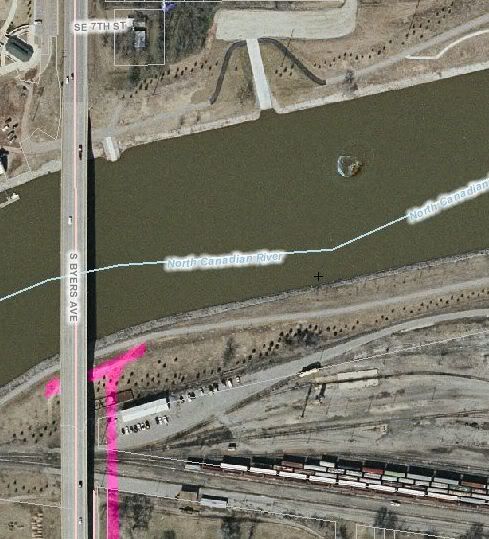
Byers Bridge LED Lights. Byers Bridge has been decorated with some new LED lights which have changing colors to dramatize the Oklahoma River area near where the rowers were based.
Click on an image for a larger view.
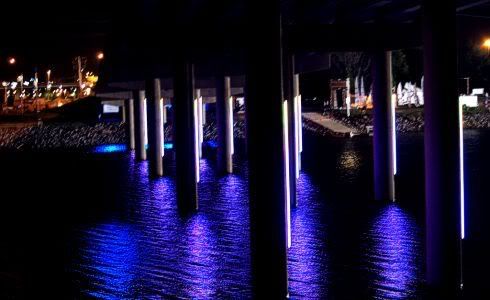


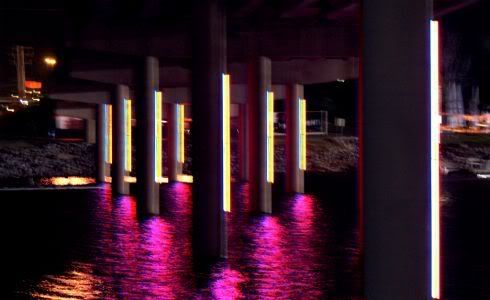
Looking North and East Along The River. I naturally didn't think to bring my tripod, but some of these turned out fairly well.
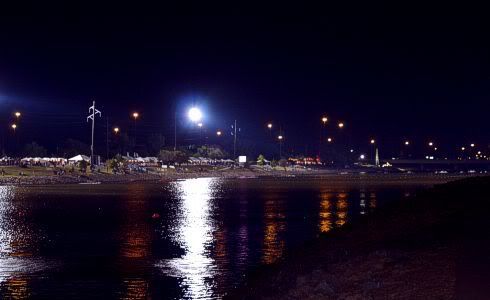

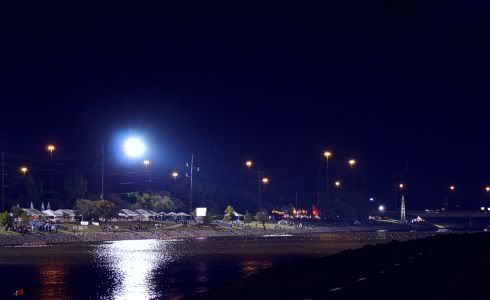
Cropped Views of the Above Picture
This one shows the Kerr-McGee Centennial Bell Tower
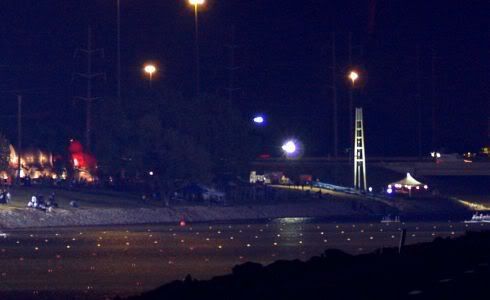
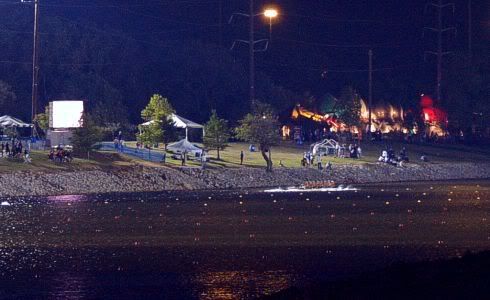
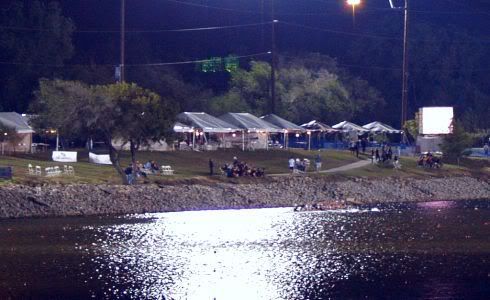
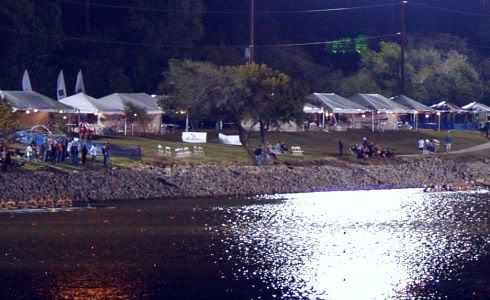
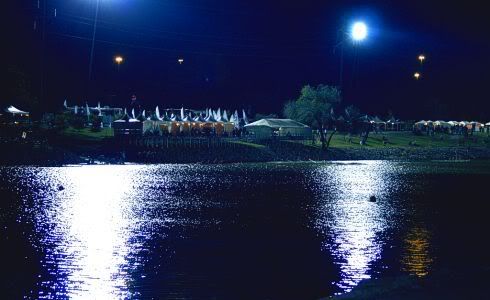
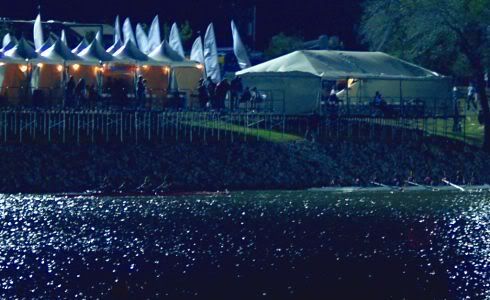

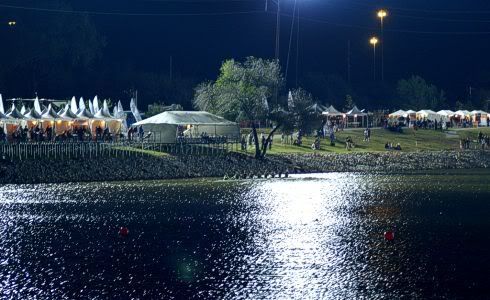
The Rowers. Unfortunately, without good lighting and at a distance, it was hard to get any pics of the rowers other than silhouettes. So, that's all I can offer ...
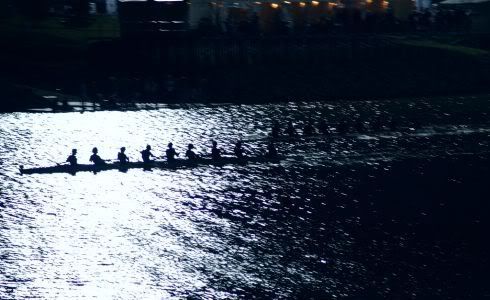
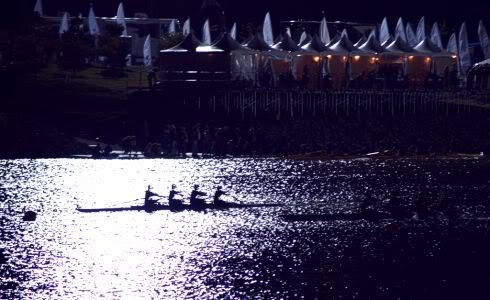
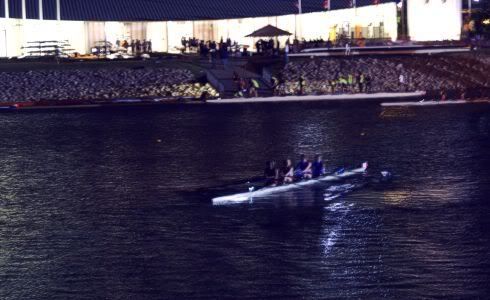

Olympic Banner. On the south side of the river, an Olympic banner which is not allowed to be used in very many places was planted into the ground. Of course, I was located at its backside but the light bled through ...
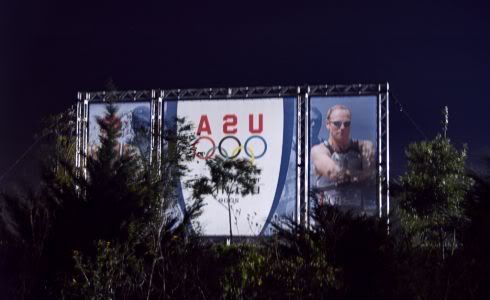
Flipping the Pic To Make It Readable
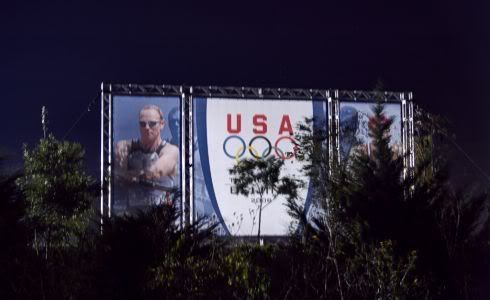
Time To Leave. We didn't stay long and after the above pics were taken we decided to leave. From the initial image at the top of this article, you may have noticed that we had to cross multiple railroad tracks to get to our vantage point ... and just as we were ready to leave, a train pulled in, and stopped! Yikes! Fortunately, after about 15 minutes or so, it moved along and we left. Coming home, I got this nice shot of downtown from Southwest 15th Street looking north ... the top of my car served well as a make-shift tripod!
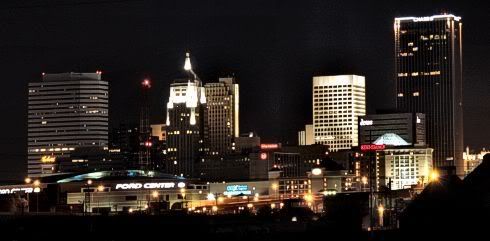
In just a few hours, on the next day, Sunday, we would attend the Centennial Parade!














1 comment:
Sounds great, but if this MAPS project lacks transparency like the many others, it is a sad demonstration of pork in OKC where the wealthy in private/public partnerships line their pockets on the backs of the taxpayers.
Post a Comment